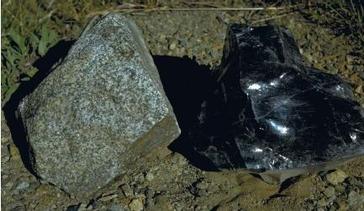Igneous rocks are called fire rocks and are formed either underground or above ground. Underground, they are formed when the melted rock, called magma, deep within the earth becomes trapped in small pockets. As these pockets of magma cool slowly underground, the magma becomes igneous rocks. Igneous rocks are also formed when volcanoes erupt, causing the magma to rise above the earth's surface. When magma appears above the earth, it is called lava. Igneous rocks are formed as the lava cools above ground. Igneous rocks begin as hot, fluid material, and the word "igneous" comes from the Latin word for fire. This material may have been lava erupted at the Earth's surface, or magma (unerupted lava) at shallow depths, or magma in deep bodies (plutons). Rock formed of lava is called extrusive, rock from shallow magma is called intrusive and rock from deep magma is called plutonic. Igneous rocks form in three main places: where lithospheric plates pull apart at mid-ocean ridges, where plates come together at subduction zones and where continental crust is pushed together, making it thicker and allowing it to heat and melt. People usually think of lava and magma as a liquid, like molten metal, but geologists found that magma is usually a mush, or, a liquid carrying a loads of mineral crystals. Magma crystallizes into a collection of minerals, and some crystallize faster than others. Not just that, but when they crystallize they leave the left over liquid with a changed chemical composition. So a body of magma, as it cools, evolves, and as it moves through the crust interacting with other rocks, it evolves more.
Minerals and Rocks By: Anna, Sarah, and Sumer

